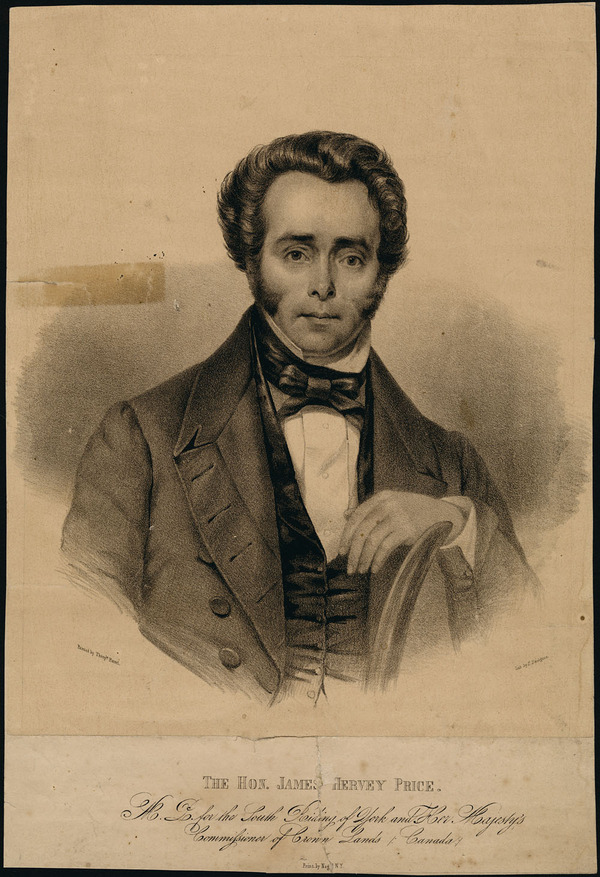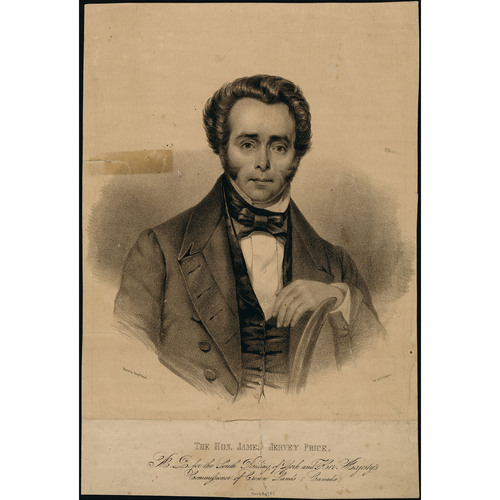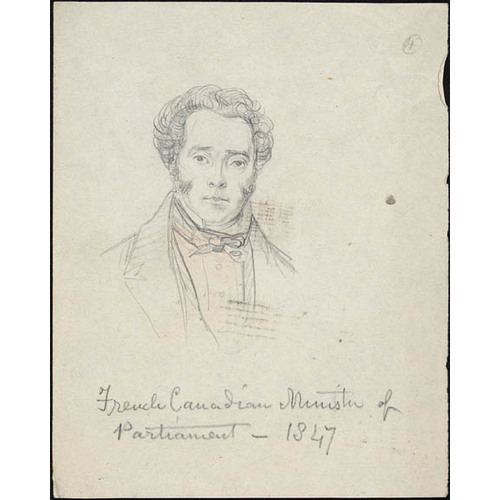PRICE, JAMES HERVEY, attorney and politician; b. in 1797 in Cumberland, England; m., probably before 1822, Elizabeth Anne Rubergall, and they had at least three sons and one daughter; d. 13 July 1882 in Shirley (Hampshire), England.
Little is known of James Hervey Price’s life before he arrived in Upper Canada in 1828 with his wife and young son, except that he had studied law at Doctors’ Commons in London. Two years after his arrival he acquired two tracts of land in York Township and built his home, Castlefield. Price continued his studies with George Rolph of Dundas, Upper Canada, and later with William Henry Draper* in York (Toronto). He was admitted to practise as an attorney in 1833 but never became a barrister. It was afterwards said of Price that he had earned the confidence of the farmers of York County by “the moderation of his charges as well as the benevolent disinterestedness of his advice.”
The Price family had been accompanied to Canada by Mrs Price’s sister, Mary Ann, who in 1830 became the second wife of Jesse Ketchum*. Between the Ketchum and Price families a close friendship developed. Influenced by Ketchum, a wealthy, prominent citizen and member of the House of Assembly for York from 1828 to 1834, Price quickly identified himself with the Reform cause. He was appointed city clerk on 3 April 1834 shortly after York was incorporated as the city of Toronto. He held the post during William Lyon Mackenzie*’s tenure as the first mayor and resigned on 26 Feb. 1835 following the Reformers’ defeat in the elections for the city council of that year. The following year he was elected as one of the councillors for St David’s Ward. With such leading Reformers as James Lesslie, Dr John Rolph*, and Francis Hincks, Price was a founder and director of the Bank of the People in 1835; he also served as its solicitor. Because he signed Mackenzie’s notes to the bank to enable him to start his second newspaper, the Constitution, in 1836, Price was obliged to repay £100 with interest when Mackenzie fled to the United States two years later.
Regardless of his Reform interests, Price remained ambivalent towards party politics. A few days after Dr Charles Duncombe* had been sent to England in the summer of 1836 to protest the methods Lieutenant Governor Sir Francis Bond Head* had used in the elections of that year, Price was called upon to subscribe towards Duncombe’s expenses. He did so, but some years later protested to Robert Baldwin* about the secret way in which Duncombe had been chosen and dispatched on this mission. It had been made to appear that Duncombe had been sent “by the Reformers as a body,” when in fact a few of the leaders had taken this decision. “This I never forgot and from that time forward I determined never to become a party man and but for my confidence in you I never should have been one.”
Price signed a declaration of the Toronto Reformers in 1837 but was not present at the secret meeting that autumn in John Doel*’s brewery during which Mackenzie proposed immediate resort to force, nor did he participate actively in the rebellion. Yet he must have been aware of what was afoot because it was at his house that Mackenzie and John Rolph met on the morning of 4 December to discuss the turn of events. That day some 300 men began to march down Yonge Street towards the city. Head hoped to persuade them to return home and felt his advice would be better heeded if conveyed by a prominent Reformer. The next day William Botsford Jarvis* asked Price to carry Head’s message under a flag of truce but Price refused, saying that he would be suspected of going to join the rebels, and suggested Baldwin or Rolph in his stead. His refusal did not prevent him from falling under suspicion. He was arrested, jailed for 13 days, and his office was pilfered. Disappointed by the setback to reform in the aftermath of the rebellion, Price, with Lesslie, Hincks, and other Reformers, became a founder and director of the Mississippi Emigration Society, formed in March 1838 to secure a tract of land in Iowa for Reformers who wanted to leave Canada. However, the society’s efforts failed.
In 1841, Price defeated John William Gamble* in the election in the 1st riding of York (York South after 1847) for the first parliament of the Province of Canada. During the first session he supported John Neilson* and Hincks in their criticisms of the act of union, consistently opposed the ministers chosen by Lord Sydenham [Thomson*], and denounced the Reformers whom the governor general had won over. Protesting the violence at the polls that had disgraced the recent elections and hampered Reform candidates, he demanded measures to ensure it would not occur in the future. Price nevertheless approved of Sydenham’s plans to create elective district councils, but joined with Baldwin in an effort to remove from the proposed legislation clauses that would permit the governor general to appoint such officials as district wardens and municipal clerks.
When Sir Charles Bagot* reconstructed the ministry in September 1842, Price did not regard it as one he could support, and he had confidence only in its leaders, Louis-Hippolyte La Fontaine* and Baldwin. It had been rumoured that Price would become commissioner of crown lands but he was not offered the post. Although he subsequently declared that he would not have entered the government, he none the less felt he should not have been overlooked. On 19 October, shortly after the new ministers had taken office, Price announced his intention to resign his seat. Baldwin urged him to reconsider as did 900 freeholders of York County who signed a petition. Price yielded.
He became a determined opponent of Sir Charles Theophilus Metcalfe* and introduced a motion in the house on 1 Dec. 1843 regretting the resignation of the La Fontaine–Baldwin ministry, brought about by Metcalfe’s policies on patronage. According to Price, if the governor general could dispense the crown’s patronage without his ministers’ advice, responsible government was only a “humbug.” Price had by now modified his views of party politics and on this occasion declared himself as having always been a party man and stated that parties were necessary for constitutional government. His motion, which prompted an important debate on the issue of responsible government, carried.
Throughout the 1840s Price introduced or supported legislation in the interests of the farmers of the Home District, accusing the government of indifference to agricultural concerns. He tried to secure good roads at provincial rather than district expense, protested high official salaries when farmers were getting “only 3/ a bushel for wheat and 10/ a hundredweight for Pork,” and wanted assessments reduced so as not to burden farmers. He also supported reforms later to be part of the Clear Grits’ programme: vote by ballot, abolition of the laws of primogeniture, and measures to ensure the legislature’s independence.
When the second La Fontaine–Baldwin ministry came to power, Price was made commissioner of crown lands, a post he held from 20 April 1848 to 27 Oct. 1851. In 1849, after a powerful speech in support of the ministry’s Rebellion Losses Bill, his lodgings in Montreal were attacked during the riots that followed its passage.
A Congregationalist, a member of Zion Church, Toronto, and a staunch voluntaryist, Price favoured provincial support for common schools and a secular university. He was determined to bring about secularization of the clergy reserves and cancellation of the rectory patents set up by Lieutenant Governor Sir John Colborne* in 1836. For a while, he accepted Baldwin’s cautious policy on these thorny issues, but in September 1849, when his intention to resign from the cabinet became known, he was rumoured to be tired of Baldwin’s temporizing. Price insisted he was simply weary of having to be absent from home for the parliamentary sessions, but Baldwin again persuaded him to change his mind. In the session of 1850 Price, speaking as a private member because of divisions within the ministry, introduced 32 resolutions dealing with the clergy reserves, which ended with a motion for an address to the crown asking for legislation to enable Canada to settle the problem itself. The motion was successful.
Price decided to contest York South again in the election of December 1851. He had tried to accelerate Baldwin’s reforms but had stood by him during the session of 1851, supporting Hincks in asking for legal adjudication of the rectories question and helping to defeat reforms desired by some Clear Grits and William Lyon Mackenzie, now returned and elected in a by-election in Haldimand County the previous April. Mackenzie visited Price’s riding in December, accused him of betraying his own constituents, and persuaded the Reform convention of York South to nominate David Gibson*. In the three-way contest that followed, both were defeated by John William Gamble, a Tory. (Price, unhappy at Mackenzie’s interference in the election, then successfully sued Mackenzie for the remaining portion of unpaid pre-rebellion debts.) A letter Price wrote to Lesslie in 1864 shows that the bitterness of the electoral defeat was deep and long lasting. “I struggled with you [the Reformers] for twenty-five years, the very prime of my life, and was thrown aside, neglected, insulted and forgotten.” Price took little part in politics thereafter.
Noted for his integrity, Price had neither speculated nor run into debt and had once boasted that he owed no bank a sixpence. When commissioner of crown lands he turned down offers from George Brown* and John Doel to buy land for him under their names. The Toronto Globe had commented in 1849 that “there is no man in Reform ranks who holds more thoroughly than Mr. Price the confidence of his party,” and that there were “few men, if any, in whom the great mass of the liberal religious denominations of Canada place such perfect reliance.”
Price had ceased to practise law by 1857 but was still resident in Toronto. By 1860 he had left Canada and was living near Bath, England, spending his time in “listless idleness.” Nevertheless he continued to correspond with his Reform colleagues, advocating dissolution of the union and independence from the crown rather than representation by population as the solution for the troubles of Canada West. He enjoyed a long life in retirement, dying on 13 July 1882 at Shirley, near Southampton, England.
AO, MU 1805–949: MU 3278; MTL, Robert Baldwin papers. PAC, MG 24, B40. Debates of the Legislative Assembly of United Canada (Gibbs et al.), I–IX. Examiner (Toronto), 12 Sept. 1849, 17 Dec. 1851. Globe, 15 Sept., 4 Oct. 1849. Dominion annual register, 1882: 356. E. J. Hathaway, Jesse Ketchum and his times: being a chronicle of the social life and public affairs of the province of Upper Canada during its first half century (Toronto, 1929). Charles Lindsey, The life and times of Wm. Lyon Mackenzie . . . (2v., Toronto, 1862; repr. 1971).
Cite This Article
Lillian F. Gates, “PRICE, JAMES HERVEY,” in Dictionary of Canadian Biography, vol. 11, University of Toronto/Université Laval, 2003–, accessed April 26, 2025, https://www.biographi.ca/en/bio/price_james_hervey_11E.html.
The citation above shows the format for footnotes and endnotes according to the Chicago manual of style (16th edition). Information to be used in other citation formats:
| Permalink: | https://www.biographi.ca/en/bio/price_james_hervey_11E.html |
| Author of Article: | Lillian F. Gates |
| Title of Article: | PRICE, JAMES HERVEY |
| Publication Name: | Dictionary of Canadian Biography, vol. 11 |
| Publisher: | University of Toronto/Université Laval |
| Year of revision: | 1982 |
| Access Date: | April 26, 2025 |





